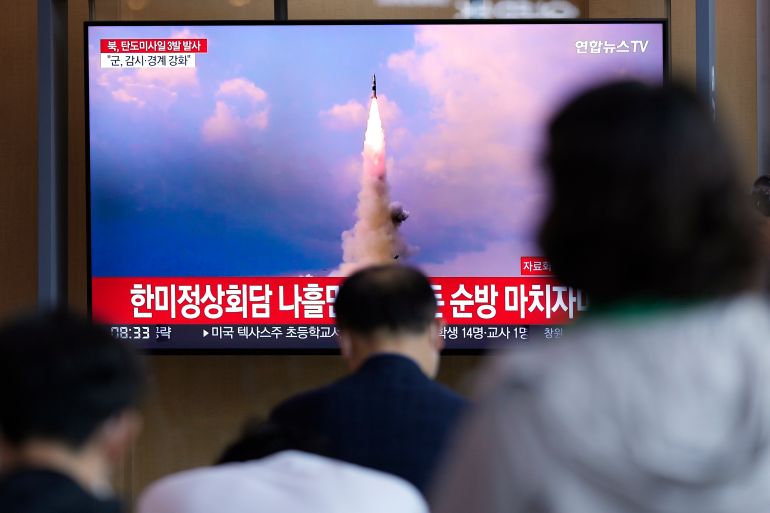N Korea fires missiles, ‘including ICBM’, as Biden ends Asia tour
South Korea, Japan condemn ‘provocations’ after North Korea fires three missiles, including a suspected intercontinental ballistic missile, off its east coast.

Seoul, South Korea – North Korea has test-fired three missiles off its east coast, including a suspected intercontinental ballistic missile (ICBM), according to the governments of South Korea and Japan.
The tests on Wednesday came hours after Joe Biden, the president of the United States, left the region following a five-day tour during which he pledged to defend South Korea and Japan in the face of North Korea’s growing nuclear and missile arsenal.
Keep reading
list of 4 itemsBiden, Yoon mull more military exercises amid N Korea tensions
Biden begins Asia tour aimed at boosting Indo-Pacific ties
North Korea shuns outside help as COVID catastrophe looms
South Korea’s Joint Chiefs of Staff (JCS) said the first missile was launched from the Sunan area in the North Korean capital, Pyongyang, at 6am local time (21:00 GMT) on Wednesday.
The second was launched 37 minutes later and the third five minutes after that.
The military said the first of the three projectiles was a suspected ICBM and flew about 360km (224 miles) with a maximum altitude of 540km (336 miles).
If confirmed, this will be the second ICBM test North Korea has conducted since Supreme Leader Kim Jong Un ended in March a four-year self-imposed moratorium on long-range missile tests. That suspension came amid a flurry of summits and diplomacy with the US that later stalled.
The second projectile appears to have failed after reaching an altitude of 20km (12 miles), the military said, while the third – a suspected short-range ballistic missile – flew about 760km (472 miles) with a maximum altitude of 60km (37 miles).
South Korea’s President Yoon Suk-Yeol, who convened a meeting of his National Security Council, condemned North Korea’s latest launches as a “serious provocation threatening international peace”. He also ordered “practical measures for the activation of extended deterrence and strengthening of the South Korea-US combined defence posture,” a statement from his office said.
‘Overwhelming power’
Shortly afterwards, the JCS said in a statement that the South Korean and US militaries fired two missiles to demonstrate their determination to respond firmly to any North Korean provocations. The missile launches were also aimed at showing that “we have the ability and readiness to precision-strike the origin of the provocation with overwhelming power”, it said.
The JCS added that it had detected signs of a possible North Korean missile “provocation” in advance and said that the South Korean Air Force had conducted a drill on Tuesday known as the “elephant walk”, which involved 30 fighter jets taxiing on the runway, in preparation for the actual weapons tests.
In Tokyo, Japanese Defence Minister Nobuo Kishi denounced the North Korean missile launches as “clear provocations” and told reporters that Japan will not tolerate Pyongyang’s attempts to advance its missile technology.
He said Japan has lodged a protest with North Korea via the Japanese embassy in Beijing, the Chinese capital.
For its part, the White House said that the US National Security Advisor Jake Sullivan spoke to his South Korean counterpart, Kim Sung-han following the latest weapons launches, and condemned the “destabilizing ballistic missile tests”. Sullivan also reaffirmed the US’s “steadfast commitment to the defense of ROK,” it said, referring to South Korea by its official name.
Wednesday’s launches marked North Korea’s 17th weapons test this year.
The show of force came after officials in the US and South Korea warned that Pyongyang was likely to test a nuclear weapon or a long-range missile soon, perhaps even during Biden’s Asia tour.
The US president had left Tokyo on Tuesday night.
Youngshik Bong, research fellow at the Yonsei University’s Institute for North Korean Studies in Seoul, said the latest launches were part of a strategy Kim announced in January 2021 to develop solid-fuel ICBMs launched from air and sea, hypersonic weapons, reconnaissance drones and a nuclear submarine. He also noted that the reaction from US and South Korea has been “quite different” to the muted responses seen during the administration of former South Korean President Moon Jae-in, who had tried to engage Kim in talks.
“The US and South Korean militaries launched their own missiles in response, demonstrating that they are ready to carry out the commitment of the US’s nuclear umbrella in its full range of options,” Bong said, referring to Biden’s commitment to Yoon during their summit in Seoul on Saturday. During that meeting, Biden had affirmed the US “extended deterrence commitment to the defense” of South Korea, “using the full range of US defense capabilities, including nuclear, conventional and missile defense capabilities”.
Biden had also promised additional measures to deter North Korea, including by potentially expanding the scope and scale of the US-South Korean joint military exercises.
The US president had also discussed Pyongyang’s nuclear and missile programmes in his meeting with Japanese Prime Minister Fumio Kishida, as well as at a summit with the leaders of the Quad grouping in Tokyo.
The latest tests come as North Korea grapples with its first confirmed COVID-19 outbreak since the start of the pandemic. More than three million people have shown symptoms of fever and at least 68 people have died since the outbreak began in late April, according to North Korean state media.
The Korean Central News Agency said on Wednesday that 115,970 people had come down with a fever the previous day, a dramatic decrease from the 392,920 cases reported on May 15.
There were no additional deaths, it said.
Zaheena Rasheed wrote and reported from Seoul, South Korea, while Kate Mayberry reported from Kuala Lumpur, Malaysia.